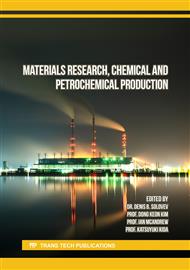[1]
S. Yang, S. Bai, Q. Wang, Morphology, mechanical and thermal oxidative aging properties of HDPE composites reinforced by nonmetals recycled from waste printed circuit boards, Waste Management. 57 (2016) 168-175.
DOI: 10.1016/j.wasman.2015.11.005
Google Scholar
[2]
S. Yang, S. Bai, Q. Wang, Preparation of fine fiberglass-resin powders from waste printed circuit boards by different milling methods for reinforcing polypropylene composites, J. Appl. Polym. Sci. 132 (2015) 42494 (1-8).
DOI: 10.1002/app.42494
Google Scholar
[3]
R.R. Rajagopal, R. Rajarao, S.T. Cholake, V. Sahajwalla, Sustainable composite panels from non-metallic waste printed circuit boards and automotive plastics, J. Clean. Prod. 144 (2017) 470-481.
DOI: 10.1016/j.jclepro.2016.12.139
Google Scholar
[4]
H.M. Veit, A.M. Bernardes, J.Z. Ferreira, J.A.S. Tenorio and C.F. Malfatti, Recovery of copper from printed circuit boards scraps by mechanical processing and electrometallurgy, J. Hazard. Mater. B 137 (2006) 1704-1709.
DOI: 10.1016/j.jhazmat.2006.05.010
Google Scholar
[5]
Z. Ou, J. Li, Synergism of mechanical activation and sulfurization to recover copper from waste printed circuit boards, RSC Adv. 4 (2014) 51970-51976.
DOI: 10.1039/c4ra08265f
Google Scholar
[6]
S. Tian, H. He, P. Yu, L. Zhou, Y. Luo and D. Jia, Sustainable utilization of waste printed circuit boards powders in HDPE-wood composites: Synergistic effects of multicomponents on structure and properties, J. Clean. Prod. 164 (2017) 840-847.
DOI: 10.1016/j.jclepro.2017.07.011
Google Scholar
[7]
J. Guo, J. Guo and Z. Xu, Recycling of non-metallic fractions from waste printed circuit boards: A review, J. Hazard. Mater. 168 (2009) 567-590.
DOI: 10.1016/j.jhazmat.2009.02.104
Google Scholar
[8]
X. Wang, Y. Guo, J. Liu, Q. Qiao and J. Liang, PVC-based composite material containing recycled non-metallic printed circuit board (PCB) powders, J. Environ. Manage. 91 (2010) 2505-2510.
DOI: 10.1016/j.jenvman.2010.07.014
Google Scholar
[9]
P. Pakeyangkoon and B. Ploydee, Impact Modification of Wood Plastic Composite from Acrylate-Styrene-Acrylonitrile and Bagasse, Adv Mat Res. 747 (2013) 355-358.
DOI: 10.4028/www.scientific.net/amr.747.355
Google Scholar
[10]
K. Friedrich, S. Fakirov and Z. Zhang, Polymer composites From Nano-to Macro-Scale, first ed., United States of America, 1945.
Google Scholar
[11]
P. Sapsrithong, K. Puksattee, K. Saewjaidee, N. Pensuk and A. Rattanapan, The Influence of Fiber Surface Treatment and SBR as Impact Modifier on Rheological Behavior and Mechanical Properties of Wood Plastic Composite from Acrylate-Styrene-Acrylonitrile and Bagasse, Key Eng. Mater. 737 (2017) 281-286.
DOI: 10.4028/www.scientific.net/kem.737.281
Google Scholar
[12]
D. Harper and M. Wolcott, Interaction between coupling agent and lubricants in wood–polypropylene composites. Compos Part A, Compos. Part A Appl. Sci. Manuf. 35 (2004) 385-394.
DOI: 10.1016/j.compositesa.2003.09.018
Google Scholar
[13]
S. Kaewkuk, W. Sutapun and K. Jarukumjorn, Effects of interfacial modification and fiber content on physical properties of sisal fiber/polypropylene composites, Composites: Part B. 45 (2013) 544-549.
DOI: 10.1016/j.compositesb.2012.07.036
Google Scholar
[14]
S.K. Muniyandi, J. Sohaili and A. Hassan, Accelerated weathering properties of compatibilized composites made from recycled HDPE and nonmetallic printed circuit board waste, J. Appl. Polym. Sci. 131 (2016) 43110 (1-12).
DOI: 10.1002/app.43110
Google Scholar
[15]
E.F. Marquès, J.A. Méndez, M.A. Pèlach, F. Vilaseca, J. Bayer and P. Mutjé, Influence of coupling agents in the preparation of polypropylene composites reinforced with recycled fibers, Chem. Eng. 166 (2011) 1170-1178.
DOI: 10.1016/j.cej.2010.12.031
Google Scholar
[16]
R.K. Das, O.K. Gohatre, M. Biswal, S. Mohanty and S.K. Nayak, Influence of non-metallic parts of waste printed circuit boards on the properties of plasticised polyvinyl chloride recycled from the waste wire, Waste Manag Res. 37(6) (2019) 569-577.
DOI: 10.1177/0734242x19836725
Google Scholar



